


Pilates workouts are getting increasingly popular these days and understandably so. Pilates is a low-impact exercise that helps to build strength and flexibility with little equipment needed. The best part? You don’t even need a gym membership.
With just a yoga mat, you can do this pilates workout at home! Perfect for those of you who are shy or lazy to hit the gym.
Key Takeaways
- Pilates is a full-body workout developed by Joseph Pilates in the early 1900s.
- Pilates can help to improve muscle strength, flexibility, endurance, and mobility.
- Pilates can be done at home with simply a mat. You don’t necessarily have to go for pilates classes to do it.
- The benefits of Pilates include improved posture, flexibility, injury prevention, and weight loss.
- Beginners can start with basic exercises at home or join a class with a certified instructor. Women who are pregnant, are advised to join a pre or postnatal pilates class with a certified instructor.
What is Pilates?
Pilates is a form of exercise that was developed by Joseph Pilates in the early 1900s. It is a full-body workout that can help to improve muscle strength, flexibility, endurance, and mobility. It helps to boost overall fitness [1].
How is Pilates usually done?
Typically, you will find people doing pilates in different ways. You may see some people using a mat for mat pilates classes or doing other pilates workouts using a reformer machine or equipment. However, pilates exercises can also be done in the comforts of your own home.
Benefits of Pilates Exercise
Pilates is suitable for people of all ages and offers quite a bit of health benefits. Some of these benefits include:
Improved posture
As you do pilates, you will find that the exercises focus on the body’s alignment, range of motion, and balancing of opposing muscles. While doing pilates exercises, you are required to practice mindfulness and awareness of your body alignment, strengthening the neglected postural muscles.
Improved flexibility and mobility
Pilates focuses on elongating and stretching muscles through controlled movements and deep breathing techniques. This helps improve flexibility by increasing the length of muscles and enhancing the range of motion in the joints.
At the same time, pilates also focuses on relaxation and mindfulness throughout the exercises. This helps to release any tension in the muscles and muscle stiffness. Thus, improving the flexibility of the body.
Prevents injuries
Pilates can help to balance the muscles so that they are not too weak and not too rigid. It helps to strengthen the muscles around the joints, reducing the risk of injury during physical activities and everyday tasks.
Helps with weight loss
While Pilates itself may not burn as many calories as high-intensity workouts like running or cycling, it does contribute to overall calorie expenditure and can help build lean muscle mass.
Additionally, Pilates improves posture, increases muscle tone, and enhances overall body awareness, all of which can support weight loss efforts.
Pilates Exercises To Try At Home
If you are new to exercising, it may make sense to go for an actual Pilates class with a certified Pilates instructor guiding you through the workout. However, if you’re comfortable with basic exercises and movements, there are plenty of resources available online. Here are some pilates exercises that you can try for a start:
Pilates Hundreds
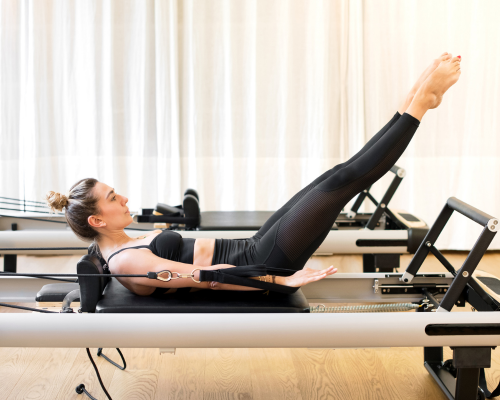
How to do it:
- Lie on your back with your knees bent and feet flat on the floor.
- Engage your abdominal muscles and lift your head, neck, and shoulders off the mat.
- Extend your legs straight to a 45-degree angle from the floor and reach your arms long by your sides.
- Pump your arms up and down in small, controlled movements while breathing in for five counts and out for five counts.
Leg Circles
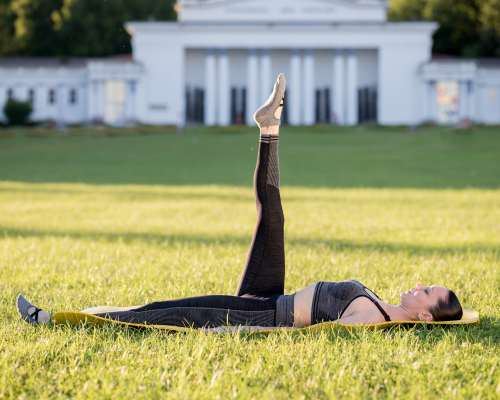
How to do it:
- Lie on your back with your legs extended straight up towards the ceiling.
- Keep your arms by your sides and engage your core muscles.
- Slowly lower your left leg down towards the floor in a circular motion, keeping it straight.
- Circle the leg back up to the starting position, then repeat the movement in the opposite direction.
- Perform the desired number of repetitions on the left leg then switch legs to your right leg.
Glute Bridges
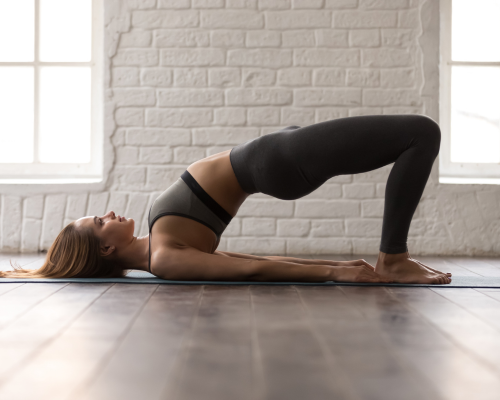
How to do it:
- Lie on your back with your knees bent and feet flat on the floor, hip-width apart.
- Engage your core and squeeze your glutes as you lift your hips towards the ceiling.
- Keep your upper back and shoulders on the mat and avoid arching your lower back.
- Hold the bridge position for a moment, then lower your hips back down to the starting position.
- Repeat for the desired number of repetitions.
Toe Tap
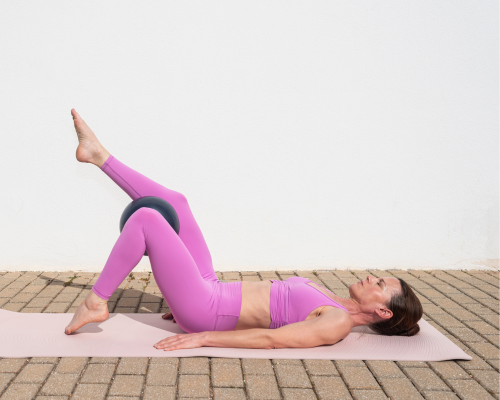
How to do it:
- Lie on your back with your knees bent and feet flat on the floor.
- Engage your core muscles and lift one leg up towards the ceiling.
- Keeping your core stable, slowly lower the lifted leg towards the floor, tapping your toes lightly on the ground.
- Lift the leg back up to the starting position and repeat on the opposite side.
- Continue alternating legs for the desired number of repetitions.
Bird Dog
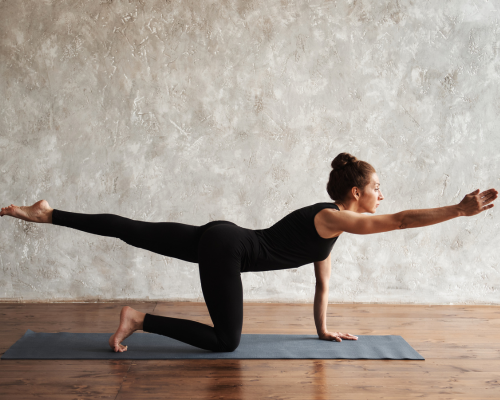
How to do it:
- Start on your hands and knees in a tabletop position, with your wrists aligned under your shoulders and your knees under your hips.
- Engage your core muscles to stabilize your spine.
- Extend one arm out in front of you while simultaneously extending the opposite leg straight back behind you.
- Keep your hips and shoulders square to the floor and avoid arching your lower back.
- Hold the extended position for a moment, then return to the starting position and repeat on the opposite side.
- Continue alternating sides for the desired number of repetitions.
Side Plank

How to do it:
- Begin by lying on your side with your legs stacked on top of each other.
- Prop yourself up on your bottom elbow and forearm, making sure your elbow is directly below your shoulder.
- Engage your core muscles and lift your hips off the mat, creating a straight line from your head to your heels.
- Hold the side plank position for the desired amount of time, keeping your body stable and avoiding sagging or rotating your hips.
- Lower your hips back down to the mat and repeat on the opposite side.
Many YouTube channels and fitness apps offer beginner-friendly Pilates tutorials and routines that you can follow from the comfort of your home. JustFit app for instance, offers a library of workouts that ranges from body part specific, workout programs to workout challenges.
Free At-Home Pilates Workout Plan with PDF
If you are looking for a home pilates workout plan, look no further. This at-home pilates workout plan is easy to follow and you can download the pdf version for free! Feel free to do this as many times as you like each week.
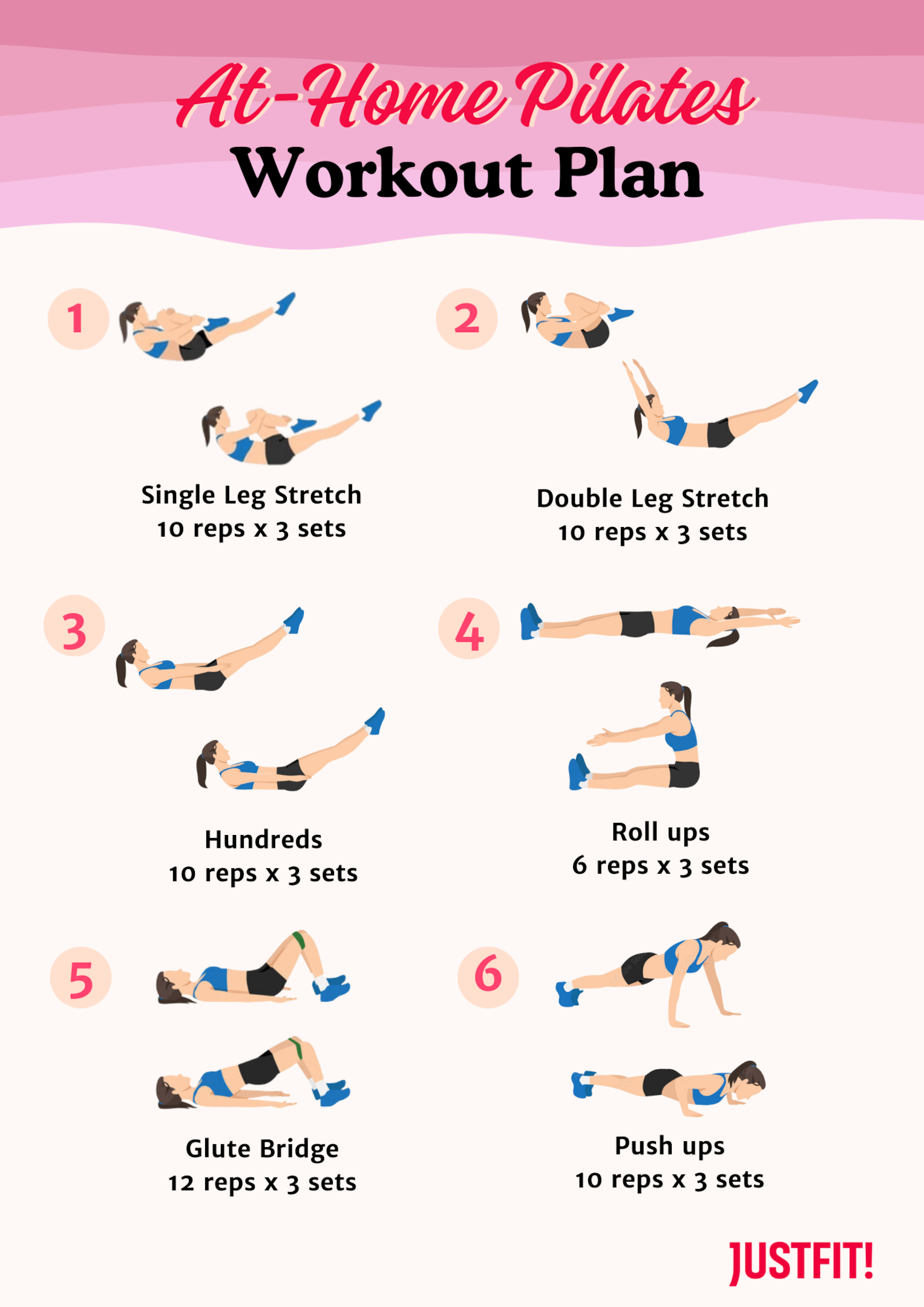
Exercises:
- Single Leg Stretch: 10 reps x 3 sets
- Double Leg Stretch: 10 reps x 3 sets
- Hundreds: 10 reps x 3 sets
- Roll ups: 6 reps x 3 sets
- Glute Bridge: 12 reps x 3 sets
- Push ups: 10 reps x 3 sets
Workout Tips
Some people may say or feel that pilates workout is not all that effective and that it does not have as much impact as high-intensity interval training (HIIT) or proper strength training. One possible reason could be that the workout is not being done properly.
So, here are a few workout tips to ensure that you are able to get the most out of your pilates session:
- Focus on Form: Proper form is crucial in Pilates to maximize effectiveness and prevent injury. Always pay attention to alignment, engage your core muscles, and move with control throughout each exercise. A good repetition is better than a sloppy repetition.
- Start Slowly: If you’re new to Pilates, you want to start off slow. Begin with easy exercises and gradually increase the intensity as your strength and flexibility improve. Rushing into advanced movements can lead to strain or injury.
- Breathe: As you are performing the exercises, ensure that you are always breathing. Coordinate your breaths with the movements. Inhale deeply through your nose to prepare, and exhale fully through your mouth as you engage your core and perform the movement.
- Listen to Your Body: Pay attention to how your body feels during and after each workout. If you experience discomfort or pain, feel free to regress to a simpler movement or seek guidance from a certified Pilates instructor.
Is It Safe for Pregnant Women?
Pilates can be safe and beneficial for pregnant women. However, certain movements and positions may need to be avoided, especially as pregnancy progresses.
Hence, you are strongly recommended to consult with a healthcare provider or to join prenatal or postnatal pilates classes with a trained pilates instructor instead of doing it at home.
Other Safety Precautions
When practicing Pilates, safety is paramount to ensure an effective and injury-free workout. Consult with a healthcare professional before beginning Pilates or any new workouts, particularly if you have any medical conditions or concerns. A healthcare provider can provide personalized guidance and ensure that Pilates is suitable for you.
Also, be mindful of any injuries that you have, pre-existing or ones that come up while exercising so that you do not end up over-exerting them.
Other Resources
If you liked this article, check out our other blogs on pilates exercises:
Summary
In summary, pilates is an effective workout to do at home. All you need is a yoga mat, and your workout clothes, and you are good to go. While you perform each exercise, you should always ensure that you are doing it with proper form. Whether you’re a beginner or an experienced practitioner, a Pilates workout at home can be a great and convenient alternative to try!
Is 20 minutes of Pilates a day enough?
Is it effective to do Pilates at home?
Is Pilates a good way to lose weight?
Can Pilates flatten your stomach?
Lawler, M. (2022) Pilates: Health Benefits, How to Get Started, and How to Get Better [online]. Available at: https://www.everydayhealth.com/fitness/pilates/guide/





